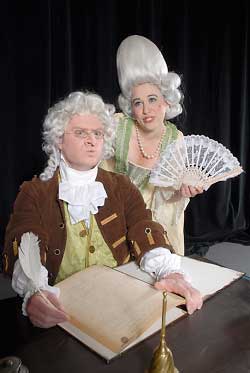A few centuries before the TV sit-com defined the bounds of popular comedic entertainment, there was Oliver Goldsmith’s dandy, “She Stoops to Conquer,” a late 18th-century play that moves away from the conventional sentimental style of the day to a brand of humor wrought from situational absurdities.

The Department of Theatre & Drama presents Goldsmith’s seminal comedy classic, written in 1771, on Feb. 15-18 at the Lydia Mendelssohn Theatre.
“I love the structure of the play,” says director John Neville-Andrews, a member of the theatre department faculty. “It’s very timely and appropriate for now: It’s about dysfunctional families.”
One character has a father, but no mother; another has a mother and no father; and then, another character makes no mention of her family. There are emotional divides between husbands and wives, fathers and sons—and then, for good measure, there’s the prototypical overbearing mother and controlling father.
“She Stoops to Conquer” follows the escapades of a young wealthy bachelor with the talent to charm barmaids, but who is painfully shy around women of social standing. When the main character travels to meet his intended fiancée, his chances of winning her hand are jeopardized in a series of incidents of mistaken identities, misassumptions and mischievousness.
The timelessness of the play, said Neville-Andrews, is derived from the appeal of brilliantly drawn characters and sparking dialogue, woven deftly into a riotous tale of manipulation and deceit. Goldsmith claimed the play was inspired by a personal experience.
After its premiere in 1773, “She Stoops to Conquer” was hailed as daringly unconventional, and credited with changing the face of Restoration comedy. Esteemed 18th-century English critic Samuel Johnson called the play the greatest play of the era.
“It’s a very joyous, uplifting play with a wonderful combination of rural and city folk duking it out until they reach common ground,” says Neville-Andrews. “Love and freedom win out in the end.”
The scenic and costume elements are inspired by the artwork of English artist Thomas Rowlandson. The stage is a three-dimensional image of Rowlandson’s artwork, a setting that evokes the theatre of Goldsmith’s time.
Joining Neville-Andrews on the artistic team is guest scenic designer Nayna Ramey, who has worked extensively with various regional theatres including American Players Theatre, Kansas City Repertory Theatre, Guthrie Theatre, and Florida Studio Theatre.
Costumes are designed by Christianne Myers, assistant professor in the Department of Theatre & Drama, whose work was seen in “The Pursuit of Persephone” and “The Cradle Will Rock.”
Department of Theatre & Drama undergraduate student Elise Handelman (“The Pursuit of Persephone”) is lighting designer. Natalie Matloke, a recent graduate in theatre and whose work was last seen in “De Organizer,” is the choreographer. Erin Kennedy Lunsford, who recently worked on “Così fan tutte,” designs wigs and make-up.
Original music for the play has been composed by Lembit Beecher, graduate student in the school.

